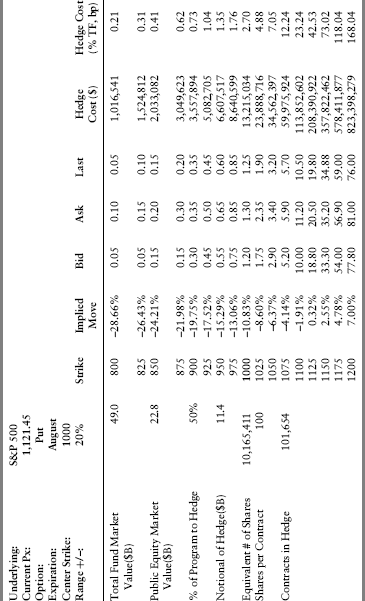S&P 500 Index Puts
On August 3, 2010, the S&P 500 index cost $1,121.45. The prices of various puts on this index are listed in Table 18.1 These puts are for strikes listed in the table's first column for expiration at the end of the month and centered on $1,000. The intent here is to show a ±20 percent range of puts prices around the current spot price for the index. To fix ideas, any strike below the current spot price ($1,121.45) is said to be out of the money (OTM) while any strike above spot is in the money. The OTM prices are of interest to us since we want to hedge downside risk.
Table 18.1 August 3, 2010, S&P 500 Puts.

Take, for example, the center strike of $1,000, which provides the option to sell the index on the strike date for $1,000. A decline in the index to this level would constitute a 10.83 percent drop in the value of the index (see the column labeled Implied Move). The asking price of the index on August 3 for this contract was $1.30 per share and the bid price was $1.20. (Note that we pay the ask price if we want the contract.) The contract, itself, is for 100 shares of the S&P 500 (each share currently worth $1,121.45).
The portfolio we want to insure is a large pension fund that has current market value equal to $49 billion and the public equity allocation in that fund is $22.8 billion. Suppose we wanted to hedge 50 percent of the public equity exposure to downside risk. In that case, the notional value of the hedge would be half the value of the equity exposure, or $11.4 billion. Since the share price of the index is currently $1,121.45, then dividing this amount into the $11.4 billion hedge target would suggest we need to purchase puts on about 10,165,411 shares, which, with 100 shares per contract, requires 101,654 contracts needed to construct the hedge.
Thus, at the strike price of $1,000, with an ask of $1.30 per share we'd have to pay $13,215,034 (equivalent shares times ask) in order to hedge 50 percent of our exposure. The last column gives us a relative sense of this cost as a proportion to fund value; for the $1,000 strike price, we'd therefore pay out 2.7 basis points of the fund to hedge a 10.83 percent decline in value. The 2.7 basis points is the insurance premium.
As the strike price declines, the cost of insurance falls with it as the market prices in the lower likelihood of the index falling to these levels. On the other hand, notice that in-the-money puts cost much more and, upon reflection, this makes sense; we are going to have to pay a premium for the right to sell our portfolio at a price higher than the current spot price. Individuals seeking the option to sell the S&P 500 for $1,200 at the end of August will pay a premium of 1.68 percent. More specifically, it will cost about $823.4 million to hedge the $11.4 billion exposure. That's for one month! This suggests that the market believes that the likelihood of the index being at this level by the end of August 2010 is quite likely and you will have to pay a premium to lock in a higher price.
Extending the analysis to tail risk, suppose we define the lower tail of the return distribution to be any return below the first percentile. Keeping things simple, if the annual expected return is 7 percent with annual volatility 15 percent, then an approximate normal density first percentile monthly return is –9.0 percent. Geometrically, 7 percent annual is 0.56 percent monthly and 15 percent annual volatility is 4.33 percent monthly volatility. The z score corresponding to the first percentile under the standard normal density is 2.31. Therefore, our tail region is any return below 1.0056 – 2.31∗4.33. The table indicates that a tail hedge would cost between 2.7 and 4.88 basis points for the month.
The takeaway from this analysis is that we can incorporate this analysis into our portfolio management and use it to manage our exposure to market risks. Therefore, if we are managing an equity portfolio and want to hedge downside (or tail) risk, we simply need to scale the amount of insurance desired and enter it into put option contracts to execute this strategy. The cost of the strategy can be assessed relative to our expectations that these losses will actually materialize as well as the cost of alternative strategies.
